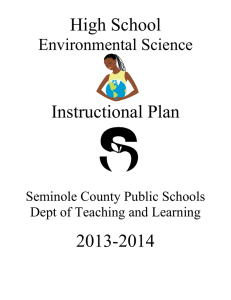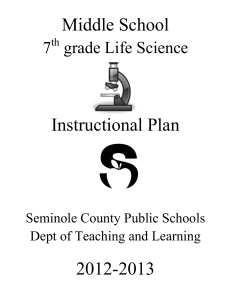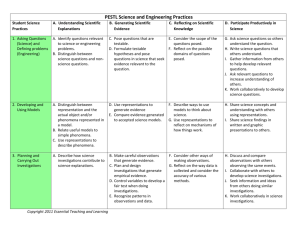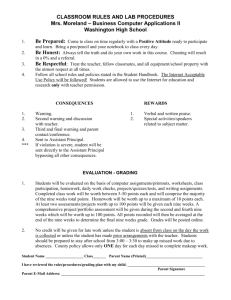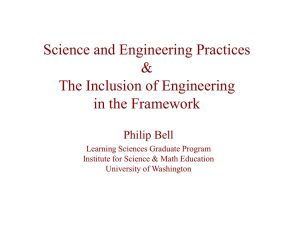Thermodynamics 3rd Nine Weeks Time Frame: 1
advertisement
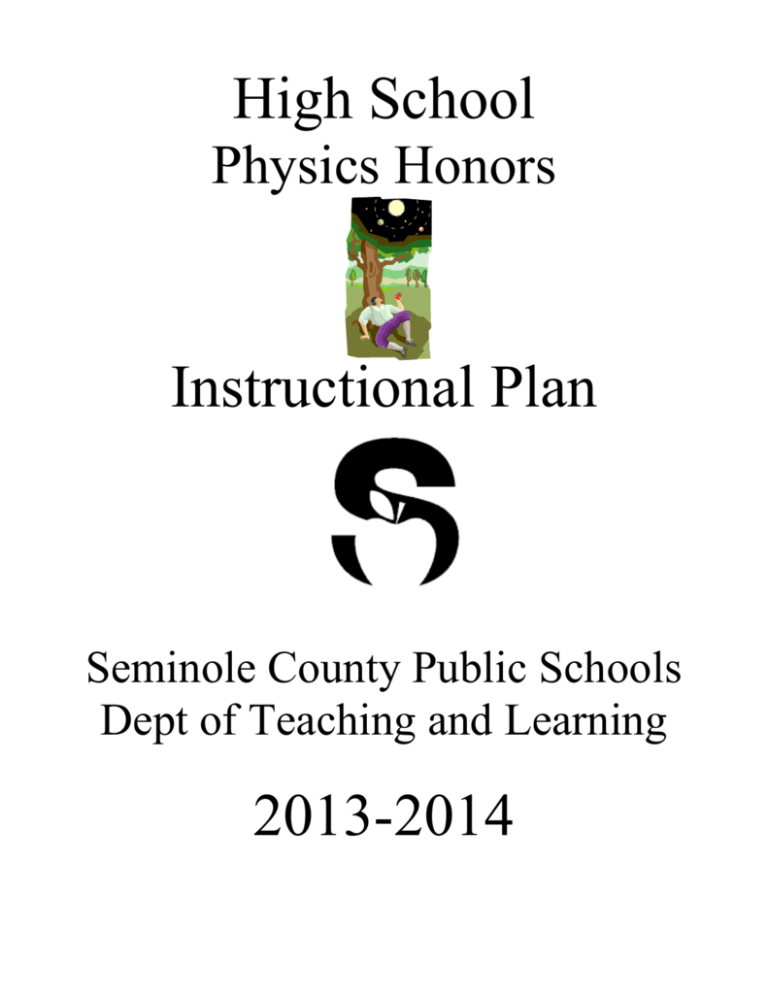
High School Physics Honors Instructional Plan Seminole County Public Schools Dept of Teaching and Learning 2013-2014 School Board of Seminole County: Karen Almond - Chair Dede Schaffner– Vice Chair Diane Bauer Dr Tina Claderone Amy Lockhart Superintendent: Dr. Walt Griffin Deputy Superintendent of Instructional Excellence and Equity: Dr Anna-Marie Cote High School Executive Director: Dr Michael Blazewitz Director of Teaching and Learning: Dr Corbet Wilson Secondary Science Specialist: Dr Rachel Hallett-Njuguna Writing Committee: Jerry Thorpe – Lake Howell HS David Llerena – Winter Springs HS Steve DeSanto – Lake Mary HS Amber Morgan – Seminole HS Sarah Zietlow – Hagerty HS Stan Cutler – Lake Brantley HS Instructional Plan for High School Physics Honors This Instructional Plan has been designed to support a common scope and sequence of classroom instruction while allowing teachers to exercise their creativity when generating lessons. Explanation of contents NGSSS Standards: these are the Next Generation Sunshine State Standards as mandated by the Florida DOE to be covered during the course Common Core Standards: these are the national standards that have been adopted by Florida for Math and Language Arts. Every science course has a few Common Core standards from both content areas embedded. These standards will not be assessed during the science course, but should be infused throughout as part of best practices. Learning Goals: these goals were selected/created to address the core concepts of each unit; a student who is able to master the learning goal with confidence and accuracy, will have mastered the benchmarks in the unit Concepts: shorthand reference to the content covered in the indicated benchmarks to help teachers understand the focus of the unit in a glance Academic Vocabulary: these words are critical for mastery of the indicated benchmarks, additional vocabulary will be found in the textbook as indicated Textbook references: relate to Holt, Physics, Adopted 2010 Lab Component Definition from FLDOE: Laboratory investigations that include the use of scientific inquiry, research, measurement, problem solving, laboratory apparatus and technologies, experimental procedures, and safety procedures are an integral part of this course. The National Science Teachers Association (NSTA) recommends that at the high school level, all students should have multiple opportunities every week to explore science laboratory investigations (labs). School laboratory investigations are defined by the National Research Council (NRC) as an experience in the laboratory, classroom, or the field that provides students with opportunities to interact directly with natural phenomena or with data collected by others using tools, materials, data collection techniques, and models (NRC, 2006, p.3). Laboratory investigations in the high school classroom should help all students develop a growing understanding of the complexity and ambiguity of empirical work, as well as the skills to calibrate and troubleshoot equipment used to make observations. Learners should understand measurement error; and have the skills to aggregate, interpret, and present the resulting data (NRC 2006, p. 77; NSTA, 2007). Instructional Practices suggested by FLDOE: Teaching from a range of complex text is optimized when teachers in all subject areas implement the following strategies on a routine basis: 1. Ensuring wide reading from complex text that varies in length. 2. Making close reading and rereading of texts central to lessons. 3. Emphasizing text specific complex questions, and cognitively complex tasks, reinforce focus on the text and cultivate independence. 4. Emphasizing students supporting answers based upon evidence from the text. 5. Providing extensive research and writing opportunities (claims and evidence). Common Core Math and Language Arts Standards for Physics Honors (should be included throughout the year, infused in lessons, but not assessed separately) LACC.1112.RST.1.1 Cite specific textual evidence to support analysis of science and technical texts, attending to the important distinctions the author makes and to any gaps or inconsistencies in the account. LACC.1112.RST.1.3 Follow precisely a complex multistep procedure when carrying out experiments, taking measurements, or performing technical; analyze specific results based on explanations in the text. LACC.1112.RST.2.4 Determine the meaning of symbols, key terms, and other domain specific words and phrases as they are used in a specific scientific or technical context relevant to grades 11-12 texts and topics. LACC.1112.RST.3.7 Integrate and evaluate multiple sources of information presented in diverse formats and media (e.g. quantitative data, video, multimedia) in order to address a question or solve a problem. LACC.1112.RST.4.10 By the end of grade 12, read and comprehend science/technical texts in the grades 11-12 text complexity band independently and proficiently. LACC.1112.WHST.1.2 Write informative/explanatory texts, including the narration of historical events, scientific procedures/ experiments, or technical processes. LACC.1112.WHST.3.9 Draw evidence from informational texts to support analysis, reflection, and research. MACC.912.F-IF.3.7 Graph functions expressed symbolically and show key features of the graph, by hand in simple cases and using technology for more complicated cases. MACC.912.N-Q.1.1 Use units as a way to understand problems and to guide the solution of multi-step problems; choose and interpret units consistently in formulas; choose and interpret the scale and the origin in graphs and data displays. MACC.912.N-Q.1.3 Choose a level of accuracy appropriate to limitations on measurement when reporting quantities. Nature of Science 1st Nine Weeks Time Frame: 1 wk (w/in rest of year too) Learning Goals: Students will be able to accurately and efficiently design and conduct scientific investigations. Students will be able to identify examples of scientific knowledge and explain the historical development of that knowledge. Students will be able to explain the importance and development of theories, laws, and models. Academic NGSSS Benchmarks (with Complexity Level) Concepts Vocabulary N.1.1 Define a problem based on physics, and do the following: pose questions about the natural world, conduct Inference systematic observations, examine books and other sources of information to see what is already known, review what Investigation is known in light of empirical evidence, plan investigations, use tools to gather, analyze, and interpret data (this Law includes the use of measurement in metric and other systems, and also the generation and interpretation of graphical Model representations of data, including data tables and graphs), pose answers, explanations, or descriptions of events, Observation generate explanations that explicate or describe natural phenomena (inferences), use appropriate evidence and Scientist reasoning to justify these explanations to others, communicate results of scientific investigations, and evaluate the Theory merits of the explanations produced by others (H) N.1.2 Describe and explain what characterizes science and its method (M) N.1.3 Recognize that the strength or usefulness of a scientific claim is evaluated through scientific argumentation, which depends on critical and logical thinking, and the active consideration of alternative scientific explanations to explain the data presented (L) N.1.4 Identify sources of information and assess their reliability according to the strict standards of scientific investigation. (H) N.1.5 Describe and provide examples of how similar investigations conducted in many parts of the world result in the same outcome. (M) N.1.6 Describe how scientific inferences are drawn from scientific observations and provide examples from the content being studied. (M) N.1.7 Recognize the role of creativity in constructing scientific questions, methods and explanations (L) N.2.1 Identify what is science, what clearly is not science, and what superficially resembles science (but fails to meet the criteria for science). (H) N.2.2 Identify which questions can be answered through science and which questions are outside the boundaries of scientific investigation, such as questions addressed by other ways of knowing, such as art, philosophy, and religion. (H) N.2.3 Identify examples of pseudoscience (such as astrology, phrenology) in society (L) Practice of Science Scientific Knowledge N.2.4 Explain that scientific knowledge is both durable and robust and open to change. Scientific knowledge can change because it is often examined and re-examined by new investigations and scientific argumentation. Because of these frequent examinations, scientific knowledge becomes stronger, leading to its durability. (H) N.2.5 Describe instances in which scientists' varied backgrounds, talents, interests, and goals influence the inferences and thus the explanations that they make about observations of natural phenomena and describe that competing interpretations (explanations) of scientists are a strength of science as they are a source of new, testable ideas that have the potential to add new evidence to support one or another of the explanations (H) N.3.1 Explain that a scientific theory is the culmination of many scientific investigations drawing together all the current evidence concerning a substantial range of phenomena; thus, a scientific theory represents the most powerful explanation scientists have to offer. (H) N.3.2 Describe the role consensus plays in the historical development of a theory in any one of the disciplines of science. (M) N.3.3 Explain that scientific laws are descriptions of specific relationships under given conditions in nature, but do not offer explanations for those relationships. (M) Laws, Theories, Models N.3.4 Recognize that theories do not become laws, nor do laws become theories; theories are well supported explanations and laws are well supported descriptions.(M) N.3.5 Describe the function of models in science, and identify the wide range of models used in science. (M) N.4.1 Explain how scientific knowledge and reasoning provide an empirically-based perspective to inform society's decision making. (M) P.8.3 Explore the scientific theory of atoms by describing changes in the atomic model over time and why those changes were necessitated by experimental evidence (H) Science and Society Atomic Theory Additional Text Vocabulary: system, hypothesis, controlled experiment, accuracy, precision, significant figures Textbook references Ancillary Materials **Key Changes** Chapter 1, Chapter 21 and 22 (briefly) For 2013-2014: suggest incorporating the atomic theory information as foundational Force and Motion 1st Nine Weeks Time Frame: 7-8 weeks (due to the loss of some time at the beginning of the year, this unit may continue into the second nine weeks) Learning Goals: Students will be able to use scalar and vector quantities to describe motion. Students will be able to describe and apply their understanding of Newton’s Laws and the four fundamental forces. NGSSS Benchmarks (with Complexity Level) P.12.1 Distinguish between scalar and vector quantities and assess which should be used to describe an event. (H) P.12.2 Analyze the motion of an object in terms of its position, velocity, and acceleration (with respect to a frame of reference) as functions of time. (H) P.12.3 Interpret and apply Newton's three laws of motion. (H) P.10.10 Compare the magnitude and range of the four fundamental forces (gravitational, electromagnetic, weak nuclear, strong nuclear) (M) Concepts Kinematics Linear Motion Academic Vocabulary Acceleration Force Frame of Reference Motion Velocity Forces Newton’s Laws Additional Text Vocabulary: displacement, average velocity, instantaneous velocity, free fall, scalar, vector, resultant, projectile motion, inertia, net force, equilibrium, weight, normal force, static friction, kinetic friction, coefficient of friction Textbook references Ancillary Materials **Key Changes** Chapters 2,3,4 *would be a good opportunity to blend some CCSS Math standards. Work, Energy, and Power 2nd Nine Weeks Time Frame: 1-2 weeks Learning Goals: Students will be able to compare work and power. Students will be able to recognize that forms of energy can be transformed from one to another including through the interpretation of potential energy diagrams. NGSSS Benchmarks (with Complexity Level) Concepts P.10.3 Compare and contrast work and power qualitatively and quantitatively (M) P.10.1 Differentiate among the various forms of energy and recognize that they can be transformed from one form to others (M) P.10.6 Create and interpret potential energy diagrams, for example: chemical reactions, orbits around a central body, motion of a pendulum Work Power Energy Transformations Potential Energy Diagrams Academic Vocabulary Energy Kinetic Energy Potential Energy Power Additional Text Vocabulary: work, work-kinetic energy theorem, gravitational potential energy, elastic potential energy, spring constant, mechanical energy Textbook references Ancillary Materials **Key Changes** Chapter 5 Momentum 2nd Nine Weeks Time Frame: 1-2 weeks Learning Goals: Students will be able to apply the law of conservation of linear momentum in collisions. Students will be able to apply the concept of angular momentum NGSSS Benchmarks (with Complexity Level) P.12.5 Apply the law of conservation of linear momentum to interactions, such as collisions between objects (H) P.12.6 Quantitatively apply the concept of angular momentum Additional Text Vocabulary: impulse, perfectly inelastic collision, elastic collision Textbook references Ancillary Materials **Key Changes** Chapter 6 and Appendix J Concepts Collisions Academic Vocabulary Angular Momentum Momentum Circular Motion and Gravitation 2nd Nine Weeks Time Frame: 1-2 weeks Learning Goals: Students will be able to describe how gravitational force relates to mass and distance. Students will be able to connect Newton’s laws and Einstein’s special relativity in terms of the speed of light. Students will be able to relate Newton’s laws to Kepler’s laws in terms of objects in the universe. NGSSS Benchmarks (with Complexity Level) P.12.4 Describe how the gravitational force between two objects depends on their masses and the distance between them. (M) P.10.10 Compare the magnitude and range of the Four Fundamental Forces (gravitational, electromagnetic, weak nuclear, strong nuclear) (M) P.12.3 Interpret and apply Newton's three laws of motion. (review) (H) P.12.7 Recognize that nothing travels faster than the speed of light in vacuum which is the same for all observers no matter how they or the light source are moving. (L) P.12.8 Recognize that Newton's Laws are a limiting case of Einstein's Special Theory of Relativity at speeds that are much smaller than the speed of light. (L) P.12.9 Recognize that time, length, and energy depend on the frame of reference. (L) E.5.6 Develop logical connections through physical principles, including Kepler's and Newton's Laws about the relationships and the effects of Earth, Moon, and Sun on each other. (H) E.5.2 Identify patterns in the organization and distribution of matter in the universe and the forces that determine them. Academic Vocabulary Force Fundamental Force: Gravity Mass Free body diagrams Orbit Moon Relativity Space Speed of light Sun Newton’s Laws Vacuum Relativity Concepts Big Bang Kepler Additional Text Vocabulary: centripetal acceleration, gravitational force, torque, lever arm Textbook references Ancillary Materials **Key Changes** Chapter 7 and Appendix J Thermodynamics 3rd Nine Weeks Time Frame: 1-2 weeks Learning Goals: Students will be able to explain the law of conservation of energy and relate it to work and efficiency. Students will be able to describe heat transfer and relate it to changes of temperature and state. Students will be able to discuss the special properties of water which allow life on Earth. Students will be able to relate temperature to average molecular kinetic energy. NGSSS Benchmarks (with Complexity Level) P.10.2 Explore the Law of Conservation of Energy by differentiating among open, closed, and isolated systems and explain that the total energy in an isolated system is a conserved quantity (H) P.10.8 Explain entropy’s role in determining the efficiency of processes that convert energy to work. P.10.7 Distinguish between endothermic and exothermic chemical reactions P.10.4 Describe heat as the energy transferred by convection, conduction, and radiation, and explain the connection of heat to change in temperature or states of matter (H) P.8.1 Differentiate among the four states of matter (M) L.18.12 Discuss the special properties of water that contribute to Earth’s suitability as an environment for life: cohesive behavior, ability to moderate temperature, expansion upon freezing, and versatility as a solvent (M) P.10.5 Relate temperature to the average molecular kinetic energy (M) Concepts Conservation of Energy Heat Energy DOE Vocabulary Conduction Conductor Convection Entropy Environment Freeze Heat Insulator Matter Radiation States of Matter Water Molecular Kinetic Energy Additional Text Vocabulary: temperature, internal energy, thermal equilibrium, specific heat capacity, calorimetry, phase change, latent heat, system, isovolumetric process, isothermal process, adiabatic process, cyclic process Textbook references Ancillary Materials **Key Changes** Chapters 9 and 10 Electromagnetism 3rd Nine Weeks Time Frame: 7-8 weeks (can be taught after Waves at the teacher’s discretion) Learning Goals: Students will be able to describe the flow of electricity through different materials. Students will be able to explore the theory of electromagnetism. Students will be able to explain the relationship between current, voltage, resistance, and power. Students will be able to explain the relationship between moving charges, magnetic fields, and electric fields. NGSSS Benchmarks (with Complexity Level) P.10.10 Compare the magnitude and range of the Four Fundamental Forces (gravitational, electromagnetic, weak nuclear, strong nuclear) (M) P.10.13 Relate the configuration of static charges to the electric field, electric force, electric potential, and electric potential energy (H) P.8.4 Explore the scientific theory of atoms by describing the structure of atoms in terms of protons, neutrons, and electrons, and differentiate among these particles in terms of their mass, electrical charges, and locations within the atom. (H) P.10.14 Differentiate among conductors, semiconductors, and insulators (M) P.10.17 Explore the theory of electromagnetism by explaining electromagnetic waves in terms of oscillating electric and magnetic fields P.10.15 Investigate and explain the relationships among current, voltage, resistance, and power (H) P.10.16 Explain the relationship between moving charges and magnetic fields as well as changing magnetic fields and electric fields, and their application to modern technologies. Concepts Fundamental Force: Electromagnetism Academic Vocabulary Conductor Current Electric Field Electric Potential Electromagnetic spectrum Insulator Magnetic field Resistance Semiconductor Voltage Electricity Magnetic Fields Additional Text Vocabulary: induction, electric potential energy, potential difference, capacitance, drift velocity, schematic diagram, electric circuit, series, parallel, magnetic domain, solenoid, generator, alternating current, back emf, mutual inductance, rms current, transformer, electromagnetic radiation, photon Textbook references Ancillary Materials **Key Changes** Chapters 16, 17, 18, 19, & 20 For 2013-2014: this Unit can be taught during the 4th nine weeks and Waves can be moved to the 3rd nine weeks (teacher’s choice) Waves 4th Nine Weeks Time Frame: 6-7 weeks (can be taught before Electromagnetism at the teacher’s discretion) Learning Goals: Students will be able to explain the relationships between the measurable properties of waves. Students will be able to describe the shift in frequency of waves due to motion of the source or receiver. Students will be able to explore the theory of electromagnetism through understanding of the electromagnetic spectrum and ray diagrams. NGSSS Benchmarks (with Complexity Level) P.10.20 Describe the measurable properties of waves and explain the relationships among them and how these properties change when the wave moves from one medium to another (H) P.10.21 Quantitatively describe the shift in frequency in sound or electromagnetic waves due to the relative motion of a source or receiver. (M) P.10.18 Explore the theory of electromagnetism by comparing and contrasting the different parts of the electromagnetic spectrum in terms of wavelength, frequency, and energy, and relate them to phenomena and applications P.10.22 Construct ray diagrams and use thin lens and mirror equations to locate the images formed by lenses and mirrors (H) E.5.8 Connect the concepts of radiation and the electromagnetic spectrum to the use of historical and newly-developed observational tools Concepts Academic Vocabulary Electromagnetic spectrum Frequency Sound Light Frequency vs Motion Wavelength Waves Light Additional Text Vocabulary: simple harmonic motion, amplitude, period, medium, mechanical wave, transverse wave, crest, trough, longitudinal wave, constructive interference, destructive interference, standing wave, node, antinode, compression, rarefaction, pitch, Doppler effect, intensity, decibel, resonance, fundamental frequency, harmonic series, timbre, beat, electromagnetic wave, reflection, angle of incidence, angle of reflection, virtual image, concave spherical mirror, real image, convex spherical mirror, linear polarization, refraction, index of refraction, lens, total internal reflection, critical angle, dispersion, chromatic aberration, coherence, path difference, order number, diffraction, resolving power, laser Textbook references Ancillary Materials **Key Changes** Chapters 11, 12, 13, 14, & 15 For 2013-2014: this Unit can be taught during the 3rd nine weeks and Electromagnetism can be moved to the 4th nine weeks (teacher’s choice)
